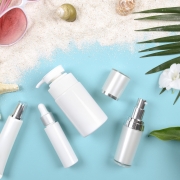Seasonal Skincare: Keeping Your Skin Healthy 365 Days a Year

For many, winter conjures images of beautiful, frozen landscapes: snow covered trees, icicles, all that good stuff. For others, the associations are less pleasant: cracked skin, chapped lips, and endless applications of moisturizer.
Love it or hate it, winter can wreak havoc on your skin. And the same is true of summer, though its effects on skin are of a different variety.
If you already have a skincare regimen in place, these seasonal changes can be frustrating. Who wants healthy, hydrated skin three seasons a year, only to have dry skin all winter? No one does. Fortunately, most of these seasonal skincare fiascos can be avoided. All it takes is a little foresight and some slight adjustments to your existing skincare routine.
Skincare and the Seasons: How the Weather Affects Your Skin
Your skin is your body’s first line of defense against the elements. And so it’s only natural that your skin changes as the weather shifts. Most of these changes have to do with the amount of moisture in the air.
During the winter, the air is cool and, for the most part, dry. Because the air is less humid than in the summer, your skin dries out much faster. This can lead to chapped and cracked skin, both of which you probably want to avoid altogether. The good news is that these effects can usually be mitigated with a slight adjustment to the moisturizing step of your skincare routine—but more on that later!
The summer typically has the opposite effect on skin. In the warmer months, the air is far more humid than it is during the rest of the year. High humidity can cause your sebaceous glands—which produce the oil on your skin—to overproduce oil. This often results in excessively oily and shiny skin.
Your seasonal skin care needs will also depend on your skin type. If you have oily skin, for example, you may find that the winter doesn’t dry your skin out too much. Summer, on the other hand, might compound and increase your skin’s natural oily tendencies. Similarly, if you have naturally dry skin, it may be perfectly hydrated during the summer, but cracked and dry during the winter.
Knowing your skin and the way it’s affected by the weather is the first step in maintaining healthy skin year-round. The second step is adjusting your skincare regimen accordingly—which we’ll dive into in the next section.
Seasonal Skincare Regimen for Oily Skin
If you have oily type skin, your usual skincare regimen should have you covered three seasons a year. That is, during winter, spring, and fall, you shouldn’t have to stray from your usual cleanser, toner, moisturizer, or SPF protection. It’s the summer weather—heat and humidity—that could throw off your skin’s balance.
As you probably know—either from research or personal experience—oily skin doesn’t do well with heavy cream and lotions. Though they cleanse and moisturize just fine, these types of products tend to exacerbate the oiliness of already oily skin. And so your skincare routine for oily skin probably includes lighter, thinner products: gels, liquid cleansers, etc.
During the summer months, you may have to make some adjustments to the moisturizing and protecting steps of your routine. If you find your skin becoming excessively oily and shiny in the heat of the summer, start by adjusting your moisturizer. Are you using a moisturizing lotion? If so, you might try switching to a gel moisturizer for the summer. Or if you are using a moisturizer and a separate product for SPF protection, consider consolidating the steps and using a moisturizer that also provides sun protection.
Remember, you’re not reinventing the wheel. These adjustments to your skincare routine don’t have to be huge. Give yourself a week to see results and then check back in. If you’re still struggling to control oily skin, make some more adjustments.
Seasonal Skincare Regimen for Dry Skin
If your skin is naturally on the dry side, you likely have what’s known as dry type skin. For most of the year, your skincare routine should stay pretty consistent: a cream cleanser, your toner of choice, a cream or lotion moisturizer, and a layer of moisturizing SPF protection. During the winter, however, you may need to take the moisturizing step of your skincare regimen to another level.
Typically, this means using a heavier cleanser. And in the world of skincare products, heavier means thicker. If you usually use a moisturizing lotion, but find it insufficient during the winter months, try a cream moisturizer.
A facial oil is another approach you can try to help tackle dull and dry skin. It can be applied after your normal moisturizer to help lock in hydration and condition the skin.
More Sun Means More Protection
The final step of a well-rounded skincare routine is applying protection. This comes in the form of products with an SPF—or sun protection factor—rating. Typically, this is sunscreen, but these days many moisturizers and even makeup products provide some sun protection.
Now this might seem like a no-brainer, but it needs to be said: the more sun you are getting, the more you need to protect your skin.
If you spend hours on end in the sun during the summer months, ramp up your UV protection. This could mean using a stronger sunscreen (you should be using at least SPF 30) or reapplying more frequently throughout the day. And ideally you should be doing both.
Skincare Changes to Avoid
Adjusting your skincare routine can be scary, even when it’s necessary. Finding the perfect combination of products takes time and consistency—and changes often seem to threaten that delicate balance. So how can you adjust your skincare routine with the seasons without throwing off the balance you’ve worked so hard to maintain?
It’s not as hard as it sounds. You just have to focus on small changes. If you make multiple changes to your current routine, it will be difficult to determine which product is the problem if the new routine doesn’t work for your skin type.
Any new moisturizers or other products that you try, should only be added one at a time. If the individual change to your skincare routine gives you healthy, vibrant skin, it’s a good sign that you’re giving your skin the nutrients and care it needs.
Consistency is Key
If you have a regular skincare routine, you know that consistency is key. The same is true for your seasonal skincare adjustments. Any change you make is only as good as the consistency with which you implement it. Sure, sunscreen one day a week is better than no sunscreen at all, but only just. So buckle down and commit to your changes. If something works, stick with it. If you don’t see the results you want, try something else. And if all else fails, consult a dermatologist.
References
https://www.cnn.com/cnn-underscored/beauty/get-skin-ready-for-summer-swimwear
https://www.dermstore.com/blog/skin-for-all-seasons/
https://health.mountsinai.org/blog/should-i-change-my-skin-care-routine-with-the-seasons/
https://www.vogue.com/article/winter-skin-care-products
https://www.health.harvard.edu/womens-health/what-to-do-about-dry-skin-in-winter













